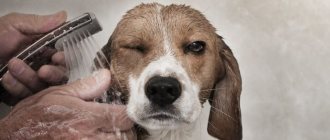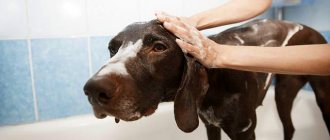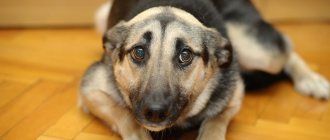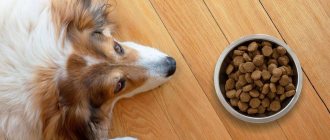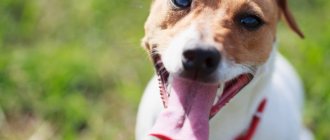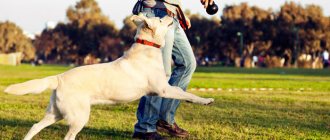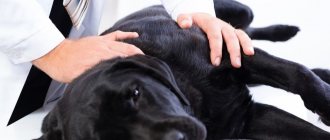How to wash a dog is a pressing question for many novice dog breeders. If you look at wild dogs, they do not bathe at all - in order to dive into a puddle or pond, the animal must have a good reason. Young dogs may not bathe due to the high-quality work of skin secretion, which actively cools the skin, disinfects it from parasites and cleans the coat. When dogs (both wild and domestic) have “bathing days,” they begin to actively wallow, removing the adhered dirt by mechanically scrubbing it off.
Often, a situation arises when a dog instinctively begins to wallow in slop, rotten meat, or worst of all, in the excrement of other animals that have an attractive smell to mask their own. In this case, the only salvation will be bathing the pet. In principle, there is nothing complicated here, but it is better to master a few simple rules that will subsequently help you wash your dog efficiently and not harm his health.
How to teach a dog to take a bath - step by step plan
The upset dog wants to get out of the bath at any cost - he breaks down and tries to jump out of it. For this reason, bathing should begin as early as possible, preferably when he is still just a puppy. However, if your pet is already an adult, there is no need to worry.
You can train your dog to bathe at any age, the main thing is consistency, patience and a good mood.
Step 1: introduction
Let the dog become familiar with the bathtub. To this end, encourage the animal to sniff it, and praise it for every sign of interest: pet it, say “well done,” give it treats that it likes to eat.
Step 2: Preparing the Site
Before sending your pet into the bathtub or shower tray, it is worth covering the bottom with a non-slip mat, perhaps a regular towel. This will make the animal feel more confident. And it will make this process much easier and faster for you.
Step 3: explore the territory
Introduce your dog to the bathroom more and more often. Let's start with one or two rehearsals a week. The dog should spend in the shower first: a few seconds, then half a minute and then 1 - 2 minutes. Gradually increase the time. And don’t forget to reward your pet for good behavior with affection or treats. This way the dog will begin to associate bathing with something pleasant.
At this stage, you do not need to wash the animal with water, just put the dog in the shower (or bath) and praise him if he does not run away.
Step 4: accustom the animal to washing
The next step is to gradually familiarize the pet with the movements we will perform during washing and how we will touch the dog. The bathtub is also an ideal place to perform basic commands such as sit, stand or wait. Therefore, if your four-legged dog knows them, take advantage of this.
Perform the movements that you will use during washing (smell the back, behind the ears, on the belly, etc.). If the dog reacts calmly, praise him.
Step 5: come into contact with water
Then you can open the tap and get used to the sound of flowing water. Please remember that dogs' skin is very sensitive. Hot water can easily burn it, so for bathing use warm water with a temperature of about 37 - 39 °C.
The intensity of the water flow and bathing time can only begin to increase when the dog remains calm during all previous stages of training.
First, bathe your pet without shampoo for 10-15 seconds, next week - for 30 seconds, etc., gradually increasing the interval.
When our student is ready for the real procedure (and this is when he stands quietly in the bathroom for 3-5 minutes), prepare a dog shampoo tailored to his individual needs (coat type, breed, etc.). And do it! We wish you success and a good relationship with your four-legged friend.
Source
Dog smell - how to get rid of it
An unpleasant dog odor may appear due to violations of maintenance standards or problems in the body. A healthy dog doesn't stink.
Ways to combat dog odor:
- carrying out wet cleaning of the house every 7 days;
- washing dog beds;
- cleaning ears of lop-eared breeds;
- eliminating junk food from the dog’s diet;
- using deodorants for dogs;
- cleaning your pet's tail;
- wiping the wool with a weak solution of water and vinegar once a month;
- brushing teeth with special brushes and pastes.
It is better to use all of these methods in a comprehensive manner, without relying on the effectiveness of only one of them.
Important! Human deodorants and perfumes should not be used to combat dog odor.
How to teach a dog to wash its fur and paws?
You need to start small: let the puppy get to know the water better. A puddle on the street or a low basin of water is suitable for this. You can throw a non-sinking toy onto the surface to encourage your baby to enter the water. You cannot force the dog - this will only cause fear and even greater reluctance to come into contact with this suspicious wet environment.
A small puppy needs to wash his paws regularly, even if this is not required, just to get used to the process. Frequent repetition of the procedure will make it familiar and non-traumatic. Most domestic dogs are completely calm about washing their paws, even handing the next paw to the owner.
The situation is more complicated when bathing in a bath or shower. Usually this procedure causes an irresistible desire in pets to run away and hide. To develop the habit of patiently enduring washing in your dog, you should use proven methods: treats and affection. Calm behavior deserves a reward.
You need to start by simply placing the dog in an empty bathtub or trough in which the procedure is usually performed. Let the dog sit in a scary place for a while. No water, just the owner’s soothing voice, stroking and treats.
At the same time, the command is repeated, with which washing will later be associated: “Wash”, “Bathe”, “Go to the bath” or any other that the owner chooses for this action. The word itself should evoke positive emotions and anticipation of a treat in the dog.
Then you can run a thin stream of warm water from the tap. The water temperature should be average, not too hot and not too cold. The shower can be turned on only when the dog gets used to the stream flowing from the tap, and only with weak pressure. Usually a wet dog starts running around like crazy - take part in the game, let him rejoice with you. And don't forget to give him a treat.
Soaping usually does not cause protest if the dog is already accustomed to the procedure itself. You just need to make sure that shampoos and conditioners do not get into your eyes, and water into your ears.
Drying process
After the bathing procedure is completed, wring out the fur as much as possible with your hands.
Next, remove the dog from the container and let him shake himself thoroughly - this is an instinctive action that cannot be avoided. Then dry your pet's fur thoroughly with towels made from highly absorbent fabrics. This should be done with gentle movements.
Photo: Christopher Connell
While drying, you should comb your pet's fur for a smoother and neater appearance.
The fastest way to dry your pet's fur after bathing is to use a hairdryer, but not all dogs tolerate this well. If your pet doesn’t like it, don’t force it, the noise of the vein can be very frightening and cause aversion not only to the hair dryer, but also to bathing and drying with towels.
If the dog is accustomed to blow-drying (usually this is done during puppyhood), then feel free to use this device. The hair dryer's air should not be hot or too intense. The direction of the air jets is along the hairline.
Photo: Christopher Connell
Remember that you should not let your dog outside until the fur is completely dry to avoid hypothermia.
Getting used to swimming
This is not so simple. Among dogs, as well as among people, there are quite a few individuals who will never fall in love with “big water” and will never cease to be afraid of it. Teaching them to enjoy bathing and swimming is almost impossible. And you shouldn’t necessarily strive for this. Swimming is not the most essential skill for a dog. Respecting a pet's inclinations is also not reprehensible for a loving owner.
But it’s still worth trying to accustom him to water.
For this purpose, choose a shallow, warm body of water with a gentle descent into the water. a small dog into the water in your arms, but under no circumstances throw it. Immerse yourself with her, so that the pet feels your hands, your support and protection. Then you can gradually remove your hands, giving the dog the opportunity to swim on its own.
The main thing is to talk to the dog all the time, calm it down, and encourage it. If your pet squeals in horror, do not make him suffer, take him ashore and leave him alone. After a strong fright, you can make the next attempt no earlier than in 1-3 weeks. If your dog still panics, stop trying until next summer or forever.
For large dog breeds the technique is slightly different. Typically, large dogs are more disciplined, so the “Come to me” command coming from the owner standing in the water can work. For dogs that love fetch, you can throw your favorite toy into the water near the shore. But in any case, you should not put too much pressure on the dog and force it to immediately and immediately start swimming.
Fear and phobia - is there a difference?
Each of us needs fear. It serves for survival and does not require adjustment. When this feeling occurs, the unpleasant sensations disappear immediately after the realization of safety.
A phobia is always a pathology. It is not supported by real reasons for concern, which prevents its elimination. Animals with this disorder have no control over their condition and constantly feel anxious in front of completely harmless things: an elevator, children's toys, a bathtub with water.
IMPORTANT!
If you suspect a phobia, be sure to consult a veterinarian and contact an animal psychologist.
How to train a puppy to take a bath
Despite the fact that most dogs are quite calm about bathing, some of them still perceive such a procedure as a kind of punishment, because they are afraid of water and soap suds. To prevent the dog from resisting bathing in every possible way and perceiving it as a terrible torture, you need to properly accustom it to this necessary ritual, which allows you to maintain the dog’s coat in proper form and prevent the occurrence of many skin diseases in dogs.
Dog owners, first of all, should remember once and for all that they need to teach their dog to bathe from a very early age. The fact is that the puppy has not yet developed a complete picture of the world around him, and if you start practicing regular bathing, then very soon he will perceive it as an ordinary procedure and throughout his life the owner will never have problems with bathing his beloved pet. Moreover, a small puppy may well perceive the bathing process as a game, and then both the dog and his owner will enjoy this hygienic procedure.
If there is a swimming pool in the house, then the owner of a dog, who has been taught to swim since childhood, may one day notice that his four-legged pet is swimming with all his might in the pool, although no one taught him this. There is nothing strange in this, because it is common knowledge that cats do not like to swim, but dogs of some breeds are always happy to frolic in the water because they have swimming skills at the genetic level. The most important thing is that the dog does not perceive the pool as a large bathtub into which he can jump at any time with dirty paws.
Adult dogs who have never liked water will definitely not lick into the pool and pollute the water in it, and the bathing process will be very painful for them. To accustom an adult dog to bathing, you can “negotiate” with it, explaining to it in every possible way that this procedure is necessary, but no one will cause it any harm. If there is a strong emotional contact between the dog and the owner, then such persuasion is often enough, but in most cases you still have to resort to some additional stimulants, such as tasty rewards after bathing, permission to do something forbidden (for example, lie on the owner’s bed). beds), as well as demonstrations of affection and care for your beloved pet.
Source
Common mistakes – we sort them out and don’t make them
In addition to coercion, there are other common mistakes to avoid. These include:
- Tying near a pond.
Never leave your dog alone near the source of his fear. If bathing together fails, accept the situation and stay close to your four-legged friend.
- Any punishment.
Negative reinforcement is effective in very rare cases, but even it excludes shouting and assault.
- Swimming in cold weather.
Even double fur will not protect you from hypothermia, so do not insist on swimming at low temperatures.
- Forced dousing.
At first, only stroking with a wet hand and light splashes during play are acceptable.
- Showing pity.
Animals are great at reading emotions. The owners' negative reactions only confirm their fears.
Remember that everything should be out of love. Once convinced that there is no real danger, the four-legged dog will quickly demonstrate the desired results and will ask to play in the water of its own free will.
Do you like the article? 0
Teaching a puppy to swim
“Cleanliness is the key to health!” This motto applies to dogs too. Timely washing helps keep the skin and coat clean, which helps reduce the negative impact of the environment on your pet, especially if you live in the city. In addition, regular hygiene and water procedures can help reduce allergic reactions of household members to dog hair, and a clean apartment is a very nice bonus. But how to teach a puppy to bathe? In this article you will find a detailed answer to this question.
The only way to avoid trouble is to not make a mistake when choosing a puppy.
Chat with the breeder. If he has nothing to hide, he will kindly answer all your questions, show his parents and conditions. Defects of the nervous system are transmitted genetically, so observe the behavior of the mother of the puppies.
One way to test temperament is through tests.
- Check your babies' reaction to noise. For example, the sound of keys falling. The “correct” puppy may be scared, but he will quickly adapt and go to see what is lying there.
- Try taking the baby to another room or outside if you have a fenced yard. See how he will behave without his brothers, sisters and mother. Bring a toy or some object. Observe the reaction.
- The baby should not bark, hide or just sit. A normal puppy is friendly and moderately curious. Of course, everyone is individual, but some reactions go beyond the norm.
Many choose the most timid and unfortunate one, because it becomes pitiful. Are you absolutely sure that you can cope with such a test? If yes, then let's find out what to prepare for.
When can you bathe a puppy for the first time?
The time of the first water procedures is determined based on the age and characteristics of the initial stage of the pet’s life. Experts recommend not bathing puppies until they are 2-3 months old.
- If you adopted a puppy at the age of 3 months, which has had all its vaccinations, then the pet is ready for a bath. However, breeders often bathe the puppy themselves immediately before handing it over to the owner to reduce stress for the pet in its new home. In the future, he needs to wash his paws with clean water after a walk, and in dirty and rainy weather use a special shampoo for paws.
- If you adopted a puppy from the street, you should immediately bathe it, regardless of age, in order to get rid of possible severe contamination of the fur. You will also need remedies for fleas and other ectoparasites. Of course, when bathing, you need to follow all the rules so that the puppy does not catch a cold, get water in his ears and get scared.
Wash your paws after a walk
After a walk, a dog's paws usually need to be treated to remove dirt, especially if they live in an apartment.
If the weather is dry outside and the dog is running on asphalt or grass, then sometimes it is enough to wipe the paws with a damp cloth; it is convenient to brush off the sand with a special soft brush.
If the dog has soiled its paws with dirt, and perhaps not only them, then it is best to wash the contaminated parts with warm water. But if your pet got into some kind of unpleasant substance (and dogs are very skillful at finding this kind of thing), then be sure to use dog shampoo or soap for daily use to wash it off (for example, Gulen , Four Paws , Shoe Zooarena brands and Pchelodar - shampoos, liquid soap, sprays for cleaning paws).
Photo: Phil Everatt
You can wash your paws after a walk either using a special basin right in the hallway, or in the bathroom, where you will either have to carry your pet (suitable for small dogs) or walk it along the corridor (large dogs will be difficult to carry and place in the bath).
To wash paws in a basin, you need to select a container of a suitable size depending on the size of the dog. It is better to use a basin with a wire rack and pour warm water from the ladle onto the paws so as not to dip them in dirty water. For small dogs, you can use a new, unused cat litter box. After washing each paw, wipe it dry with a soft cloth.
The most convenient way to wash paws in the bathroom is with a shower - a stream of water perfectly cleanses dirt. You should wipe your paws dry after completing the procedure.
If you use a hygiene product to wash your paws, first dilute it in a small amount of water. Then apply to paws and massage lightly, then rinse thoroughly. Do not put too much pressure on the pads, as there may be microtraumas on them after a walk. Sprays are simply applied to the paws and wiped with a cloth.
After washing and drying the paws, inspect the pads for any damage (peeling, cracks, irritation). If detected, it is recommended to apply a special cream or spray to care for paw pads (for example, Pchelodar , Care , Trixie ).
Private homes often have a separate shower section for dogs.
Paw washers of different sizes
There is also a special device for washing dog paws - a paw washer. This is a container shaped like a vase or a large mug; inside there are soft brushes, and on top there is a restrictive rubber band that prevents water from splashing. Before use, pour water into the paw washer, then simply insert the dog’s paw and make several up and down movements with the device.
Preparing for your first swim
To make the bathing procedure easy and stress-free, use the following tips.
- It is better to wash in the evening after a walk.
- A towel or rubberized mat should be placed on the bottom of the bathtub or basin so that the puppy’s paws do not slip and he is not afraid.
- You need to clarify in advance what bathing features are specific to your pet’s breed (for example, the use of balm).
Before the procedure, prepare everything you need:
- a basin if you are not bathing the puppy in the bathtub;
- rubberized mat or towel-bedding;
- shampoo intended for puppies;
- two clean towels;
- delicacy.
You should be especially careful when purchasing shampoo. For sensitive and delicate skin of puppies, you need to choose products with a delicate composition. For example, “Gentle” pet shampoo with aloe vera, lanolin and chitosan (natural conditioner). It foams well, helps prevent excessive degreasing of the skin and dandruff, and makes the coat shiny.
For animals with long, thick hair, you will also need a conditioner or balm, preferably from the same series as the shampoo. Read the instructions carefully and choose products that suit your pet's coat type.
Remember that shampoo should not be used unless absolutely necessary. The puppy's skin and coat are protected by natural lubrication produced by the skin glands. Excessively frequent washing can provoke increased secretion of lubricant, accompanied by a sharper and more unpleasant odor from the dog. When bathing with water without detergents, the skin's natural protection is not impaired.
Hygiene products
The veterinary pharmacy and pet store have a wide selection of bath and soap accessories for pets. Special shampoos for dogs match the acidity of the pet’s skin and do not cause a negative reaction from the dog’s body (itching, dandruff, allergies).
When choosing a detergent, you should pay attention to the nature of the coat. For long-haired and short-haired breeds, special formulas have been developed that take into account the peculiarities of the structure of the hair and undercoat.
The range of detergents also includes special shampoos with a therapeutic effect: for dandruff, excessive shedding, itchy skin, and hypersensitivity. They contain medicinal plants and beneficial components, such as lanolin. To combat parasites, shampoos with insecticidal properties are produced.
Shampoos for dogs
In addition to shampoo, conditioners are used for bathing dogs. The products improve the structure of the hair, make it easier to comb long hair, and add shine and silkiness.
You might be interested
How to properly trim a dog's nails - tools and safety precautions
Trimming and filing nails is one of the hygiene procedures necessary for a dog. As a rule, growing…read more
Stages of tooth change in puppies and related problems
All dog breeds have two types of teeth - molars and milk teeth. Puppies have up to …read more
What is important to know about trimming and which dogs need it?
Each breed of dog requires utmost attention and an individual approach. The trimming procedure is perfect…read more
Features of washing depending on the size of the pet
Small dogs are easy to bathe and can be easily held with one hand. Some small breed pets do not need frequent washing at all.
Large dogs are more difficult to restrain, but if the animal is trained, it will accurately carry out all spoken phrases and commands.
Additional Information. Many people are interested in how to wash a puppy. It is generally not recommended to bathe babies; the fur just needs to be carefully combed out. In extreme cases, the procedure is carried out very carefully so as not to harm or frighten the puppy.
Knowing how to properly wash a dog at home, the pet owner will be able to turn the procedure into pleasure and not torture. The question requires care and accuracy. It is recommended to accustom the animal to water procedures from early childhood, always reward it for correctly performed tricks, and do not try to force it into water or a river. For the procedure, it is better to choose specialized shampoos and balms, otherwise allergic reactions may develop after some time.
